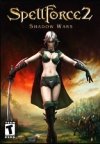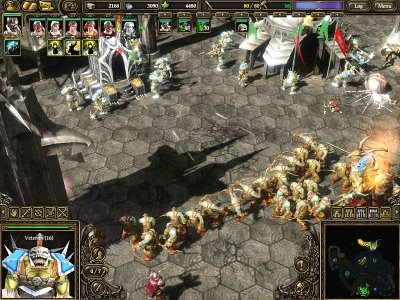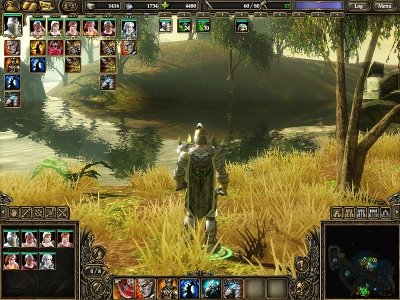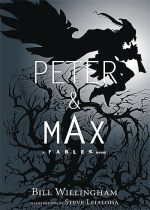Game Review: SpellForce 2
 SpellForce 2: Shadow Wars
SpellForce 2: Shadow Wars
(8.5 of 10)
Platform: Windows (PC)
Publisher: Aspyr Entertainment
Developer: Phenomic
Introduction
As far as I can remember, Warlords Battlecry was the first to incorporate the hero system with role-playing elements in a real-time strategy game. Since then, real-time strategy game developers started following that trend. Phenomic, however, took a bold step with their 2004 game, SpellForce: The Order of Dawn, by adding more role-playing elements –other than a hero with skills and attributes- in a real-time strategy game, creating a seamless blend between the RTS and RPG genre. Now, the series returns with SpellForce 2: Shadow Wars, which is a much more polished game that casts a brighter glow than its predecessor.
Story
 Sorvina, leader of The Pact
Sorvina, leader of The PactGameplay
The core features that made SpellForce: The Order of Dawn unique are still present in the sequel. Although others have been simplified and improved for ease of use.
The avatar in The Order of Dawn, The Rune Warriors, has been replaced by the Shaikan, a powerful and nearly immortal dragonblooded race. Other Shaikans will accompany you throughout your quest as well, replacing the boring Rune Gem Heroes. Unlike the Rune Heroes, your Shaikan companions gain levels, although not as much as your avatar do. The Shaikan also has the power to perform The Blood Ritual, an innate ability to resurrect a fellow dragonblood. With the concept of the Shaikan’s power, the hero revival system is much more convenient now compared to the first game. Since your companions are all dragonblooded, you can be easily raised by one of them on the spot when you’re killed, and you can do the same for them as well. No more arduous task of searching for and running to the nearest hero monuments to raise a companion.
Like all, if not most, RPGs, your character and party members will earn experience and gain levels. SpellForce 2 is no different. However, character development has been simplified and, therefore, lacks depth. There are no attributes to develop, and the characters just gains an amount of mana and hit points each level up. The skill system is shallow as well. There are only two skill trees in the game, Combat and Magic, and each tree branches out deeper into a more powerful skill. Putting points into a skill won’t intensify its effects. Instead, you will be able to use a specific item and unlock certain spells and/or abilities. Each skill can be also maxed out with only three points, leaving you with more skill points to distribute in other skills and making your character a jack of all trades instead of an uber-powerful specialized hero.
The RTS aspect in SpellForce 2, like the role-playing, has also been simplified. The races have been compounded into factions. Instead of separately controlling Humans, Elves, and Dwarves, you’ll be playing them together as The Realm. This also applies for The Clans (Trolls, Barbarians, and Orcs) and The Pact (Dark Elves, Gargoyle, and Shadows). There are also fewer resources to gather this time, eliminating food, wood, and aria from the list. The units are also less complex and usually have one attack type and/or a passive ability. Rune Workers, like the Rune Warriors and Heroes, have also been removed from the game. Instead, NPCs will provide you with workers so you could start gathering resources and building camps. Building plans and unit plans are also no longer available in the game, so players won’t have any trouble looking out for this stuff throughout the game.
One might think that SpellForce 2, with its shallow game elements from both genres, is an abysmal game. However, less is more and in SpellForce 2 it’s less micromanagement and more fun. Keep in mind that you’re playing two different game styles simultaneously. So while you’re raising an army and gathering resources, you’ll also be running around the map doing some quest, managing your large inventory, or distributing skill points. In combat, your simplified units don’t need a lot of micromanaging since they’ll only do one specific thing, and they will do so automatically. This leaves you with a lot of room to focus on your hero and party, which are the real punch-packers in combat.
Game Modes
The campaign is epic enough and it took me two weeks to finish it. If you can’t get enough of SpellForce 2, however, there are two other single-player modes: the Freeplay and Skirmish. In Freeplay Mode, you’ll start out in Westguard, a small duchy or county that your avatar established in the campaign. From there, you’ll be able to see all of Eo and receive some random quests. In short, Freeplay Mode is an open-ended RPG and the Skirmish Mode, is a real-time strategy game. Both Freeplay and Skirmish Modes are also available in online multiplayer. However, there are only a few people to be found playing online. So you might have a hard time finding a worthy opponent for a skirmish battle or a good partner for a co-op play.
Graphics & Sounds
The graphics of SpellForce 2 is no Oblivion, or even next-generation worthy. It’s decent enough, however, and it’s a great improvement compared to its predecessor. There is more amount of detail in the textures this time. The glow and lighting effects are really scintillating -especially if the light of day hits the adamantium plate you’re wearing. There are also a variety of good armor, shield, and weapon designs. Sometimes, you’ll even find it hard to change a weapon or armor because it just looks too cool to be discarded even though its modifiers are useless. The shadow, unfortunately, are blocky and too jagged at some areas. Even setting it to high and cranking the anti-aliasing to 6 won’t change it.
Besides the passably decent voice acting, the audio in SpellForce 2 is really unremarkable. The effects are too generic and the music fails to compliment the atmosphere or pump any adrenaline when in combat.
Conclusion
If you individually look at the role-playing or the strategy elements in SpellForce 2, you’ll see a poor game that lacks depth. Fortunately, you’ll get both games that are seamlessly blended to bring out a new type of game experience. One minute you’re solving a mysterious quest and with a blink of an eye you’ll notice that you’re amassing an army to assault an impregnable fortress. If you liked the first game, or you’re looking for something new, I’m certain you’ll love SpellForce 2: Shadow Wars. Unfortunately, to those who are looking for good RPG or a good RTS experience, SpellForce 2: Shadow Wars might be a let down.















0 comments:
Post a Comment